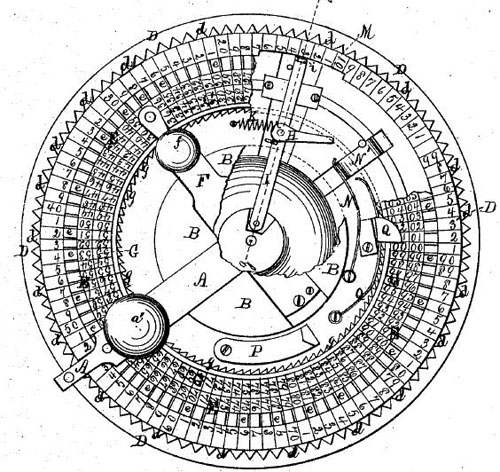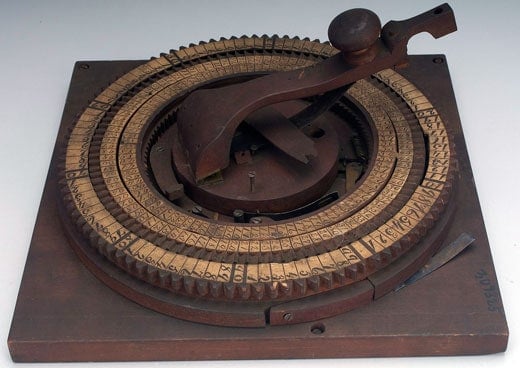Key Points:
- Elmore Taylor, an inventor originally from Franklin Indiana, held patents for multiple devices, including a circular adding machine. His first patent was obtained at the age of 19.
- Elmore Taylor’s older brother Dick helped him secure a financial assistant job at the First National Bank of Franklin. Dick then swindled the bank out of $100,000, causing the bank to close.
- Elmore relocated to Detroit after his brother’s crime was discovered, where he became a photographer and also obtained the majority of his patents.
Elmore Taylor
In 1874, Elmore W. Taylor of Franklin, Indiana, patented a circular adding machine (US patent 155772), assigning one-half to his brother Richard T. Taylor. The patent model of the device (up to 1880, the US Patent Office required inventors to submit a model with their patent application) is still preserved in the National Museum of American History, Washington, D.C. (see below). This is the only surviving device and it obviously never became popular.

The adding machine of Elmore Taylor is a circular adder, made of wood, metal, and paper, with overall measurements of 14.5 cm x 30.5 cm x 30.5 cm. It is intended to be used for adding columns of figures, two places at a time.
Its wooden base supports three concentric wooden rings and a central mechanism. The outer fixed ring has a serrated outer edge. The 100 serrations are numbered from 1 to 99 (the 0 serration isn’t numbered) on a paper ring fixed to the surface of the ring. Inside this ring is a movable ring, grooved or notched with 100 upward-facing serrations around its edge. These are numbered on the adjacent piece of paper from 00 to 99. Inside this ring is a third fixed ring, serrated on the inside, and also carrying a numbered slip of paper numbered from 00 to 99
Two wooden arms are mounted on a rotating wooden platform at the center of the instrument. The larger arm is designed to link to the two outer rings and the smaller one to the middle ring only. The machine has a carry (by means of a pivoted arm and a pawl) from the tens to the hundreds place.

Elmore (or Elmer) W. Taylor was born in 1847 in Franklin Township, Johnson County, Indiana, in the family of John W. Taylor (b. 1810) and Nancy Taylor (b. 1811). Elmore had 3 sisters (Aletha A., b. 1840; Mary E., b. 1844, and Hannah J., b. 1849) and 2 brothers (Pierson T., b. 1834 and Richard T., b. 1843).
Elmore was evidently quite mechanical from a young age, as he obtained his first patent in 1866 at the age of 19. Elmore’s older brother Dick worked as a cashier at the First National Bank of Franklin and helped secure Elmore a job as an assistant cashier. In 1877, Dick fled the town but mailed Elmore a letter informing him that he had doctored the books in the bank, paid dividends to stockholders without earning them, and deceived bank examiners. The bank was closed to investigate the matter, and it was found that Dick Taylor had swindled upwards of $100,000. Dick was never convicted of the crime — rather declared insane after being found a year later destitute. Because of these unfortunate events, Elmore moved to Detroit.
Elmore married Margaret A. Toner (born 1857) on October 5, 1876. In the 1880s while residing in Detroit, he worked as a photographer. He also became the holder of 5 US patents (besides the adding machine, he patented also an evaporator (1866), an advertising device (1880 and 1883), and a roller skate (1882)).
The image featured at the top of this post is ©Unknown author / public domain


